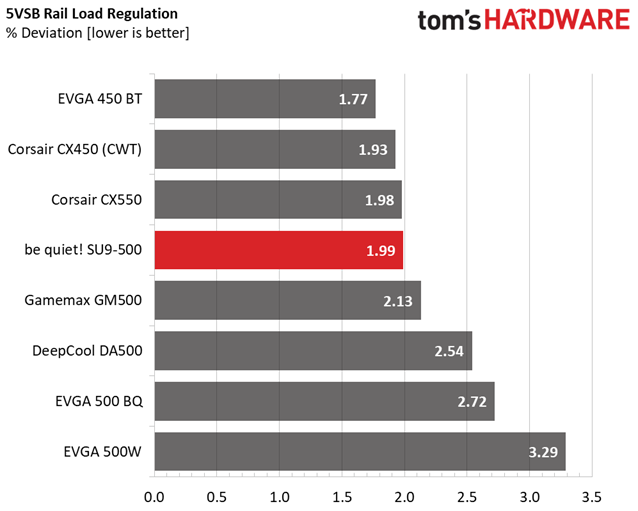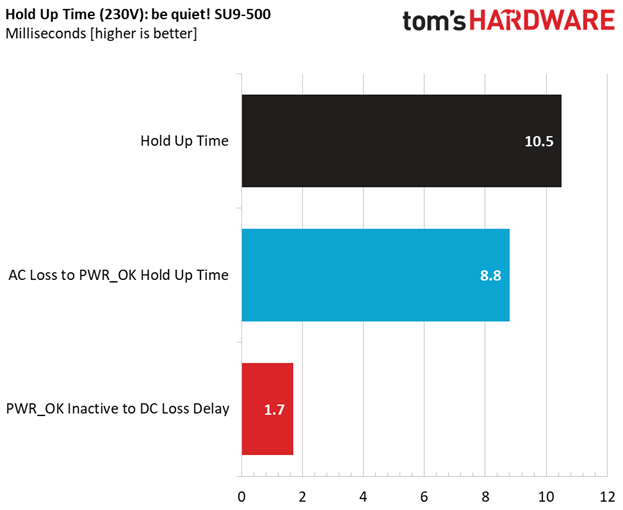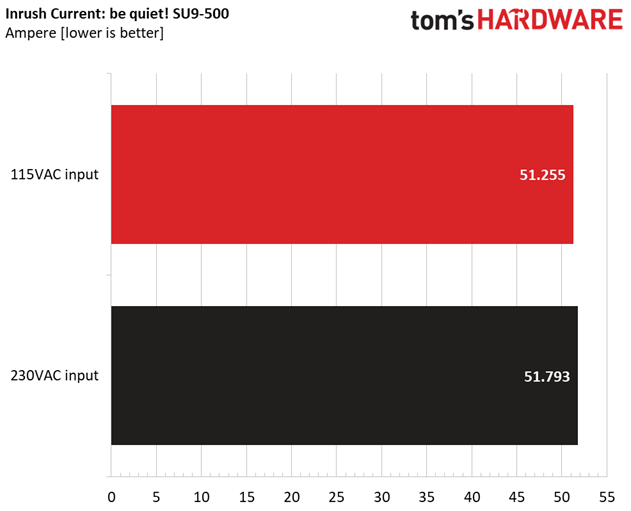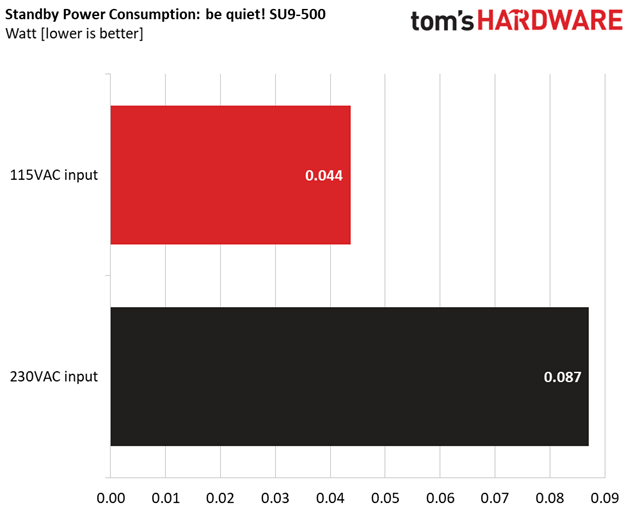be quiet! System Power U9 500W PSU Review: Affordable and Quiet
Why you can trust Tom's Hardware
Load Regulation, Hold-Up Time, Inrush Current, Efficiency and Noise
To learn more about our PSU tests and methodology, please check out How We Test Power Supply Units.
Primary Rails And 5VSB Load Regulation
The following charts show the main rails' voltage values recorded between a range of 40W up to the PSU's maximum specified load, along with the deviation (in percent). Tight regulation is an important consideration every time we review a power supply because it facilitates constant voltage levels despite varying loads. Tight load regulation, among other factors, improves the system’s stability, especially under overclocked conditions and, at the same time, it applies less stress to the DC-DC converters that many system components utilize.








The load regulation is pretty tight on all rails. Because the unit lacks modular connections, the voltage drops on the cables are low. The CX450 and the 450 BT achieve even lower deviations; however, they also have 50W less to deal with.
Hold-Up Time
Put simply, hold-up time is the amount of time that the system can continue to run without shutting down or rebooting during a power interruption.




The hold-up time is much lower than 17ms but the power ok signal is accurate, at least. The bulk caps are among the most expensive parts in a PSU so in this category, the manufacturers try to use the lowest possible capacity to save money.
Inrush Current
Inrush current, or switch-on surge, refers to the maximum, instantaneous input current drawn by an electrical device when it is first turned on. A large enough inrush current can cause circuit breakers and fuses to trip. It can also damage switches, relays, and bridge rectifiers. As a result, the lower the inrush current of a PSU right as it is turned on, the better.


The registered inrush currents are at normal levels. We expected higher readings given the lack of a bypass relay, but the small bulk cap helps here.
Get Tom's Hardware's best news and in-depth reviews, straight to your inbox.
10-110% Load Tests
These tests reveal the SU9-500’s load regulation and efficiency levels under high ambient temperatures. They also show how the fan speed profile behaves under under increased operating temperatures.
| Test # | 12V | 5V | 3.3V | 5VSB | DC/AC (Watts) | Efficiency | Fan Speed (RPM) | PSU Noise (dB[A]) | Temps (In/Out) | PF/AC Volts |
|---|---|---|---|---|---|---|---|---|---|---|
| 1 | 2.301A | 1.989A | 1.990A | 0.991A | 49.577 | 81.433% | 618 | 9.7 | 37.03°C | 0.960 |
| 12.161V | 5.028V | 3.313V | 5.047V | 60.881 | 41.86°C | 115.10V | ||||
| 2 | 5.663A | 2.985A | 2.988A | 1.191A | 99.682 | 85.869% | 618 | 9.7 | 37.82°C | 0.971 |
| 12.148V | 5.024V | 3.310V | 5.038V | 116.086 | 43.66°C | 115.09V | ||||
| 3 | 9.353A | 3.485A | 3.474A | 1.392A | 149.544 | 87.135% | 628 | 9.9 | 38.10°C | 0.979 |
| 12.141V | 5.021V | 3.308V | 5.029V | 171.624 | 45.07°C | 115.09V | ||||
| 4 | 13.053A | 3.986A | 3.990A | 1.594A | 199.568 | 87.377% | 613 | 9.6 | 38.55°C | 0.984 |
| 12.133V | 5.018V | 3.306V | 5.021V | 228.399 | 47.57°C | 115.09V | ||||
| 5 | 16.429A | 4.986A | 4.992A | 1.796A | 249.697 | 87.048% | 626 | 9.9 | 39.24°C | 0.987 |
| 12.125V | 5.015V | 3.304V | 5.010V | 286.849 | 49.70°C | 115.08V | ||||
| 6 | 19.808A | 5.984A | 5.994A | 2.000A | 299.764 | 86.487% | 624 | 9.9 | 39.64°C | 0.989 |
| 12.115V | 5.013V | 3.302V | 5.000V | 346.599 | 51.73°C | 115.08V | ||||
| 7 | 23.193A | 6.987A | 7.000A | 2.204A | 349.900 | 85.578% | 829 | 15.8 | 40.01°C | 0.990 |
| 12.107V | 5.010V | 3.300V | 4.990V | 408.865 | 53.20°C | 115.08V | ||||
| 8 | 26.581A | 7.991A | 8.002A | 2.410A | 400.007 | 84.666% | 1144 | 25.8 | 40.47°C | 0.991 |
| 12.099V | 5.007V | 3.298V | 4.980V | 472.452 | 55.50°C | 115.08V | ||||
| 9 | 30.380A | 8.493A | 8.492A | 2.413A | 449.723 | 83.766% | 1518 | 34.5 | 41.41°C | 0.992 |
| 12.088V | 5.004V | 3.296V | 4.974V | 536.881 | 58.09°C | 115.08V | ||||
| 10 | 34.185A | 8.998A | 9.016A | 2.517A | 500.049 | 82.798% | 1815 | 39.2 | 42.18°C | 0.993 |
| 12.077V | 5.001V | 3.294V | 4.966V | 603.938 | 59.45°C | 115.08V | ||||
| 11 | 38.321A | 9.003A | 9.019A | 2.520A | 549.666 | 81.836% | 1812 | 39.2 | 43.27°C | 0.994 |
| 12.068V | 4.999V | 3.293V | 4.961V | 671.668 | 60.98°C | 115.08V | ||||
| CL1 | 0.135A | 12.999A | 12.998A | 0.000A | 109.634 | 80.163% | 628 | 9.9 | 39.32°C | 0.976 |
| 12.155V | 5.009V | 3.299V | 5.040V | 136.763 | 50.10°C | 115.10V | ||||
| CL2 | 40.001A | 1.000A | 1.000A | 1.000A | 496.651 | 83.737% | 1815 | 39.2 | 42.11°C | 0.993 |
| 12.083V | 5.010V | 3.301V | 5.008V | 593.109 | 59.24°C | 115.08V |
The cooling fan spins at full speed only during the full load and overload tests, even with higher than 40°C ambient temperatures. This is impressive considering the platform's not so high efficiency. Speaking of efficiency, the unit easily meets the 80 PLUS Bronze requirements with 20%, 50% and 100% load and the power factor readings are high enough, as well.
20-80W Load Tests
In the following tests, we measure the SU9-500's efficiency at loads significantly lower than 10 percent of its maximum capacity (the lowest load the 80 PLUS standard measures). This is important for representing when a PC is idle, with power-saving features turned on.
| Test # | 12V | 5V | 3.3V | 5VSB | DC/AC (Watts) | Efficiency | Fan Speed (RPM) | PSU Noise (dB[A]) | PF/AC Volts |
|---|---|---|---|---|---|---|---|---|---|
| 1 | 1.187A | 0.498A | 0.480A | 0.197A | 19.532 | 71.305% | 620 | 9.8 | 0.926 |
| 12.162V | 5.032V | 3.315V | 5.067V | 27.392 | 115.13V | ||||
| 2 | 2.436A | 0.993A | 0.993A | 0.395A | 39.907 | 80.375% | 624 | 9.9 | 0.947 |
| 12.160V | 5.030V | 3.314V | 5.061V | 49.651 | 115.13V | ||||
| 3 | 3.620A | 1.491A | 1.479A | 5.055A | 59.407 | 83.661% | 618 | 9.7 | 0.965 |
| 12.157V | 5.028V | 3.313V | 5.055V | 71.009 | 115.11V | ||||
| 4 | 4.873A | 1.988A | 1.990A | 0.792A | 79.804 | 85.313% | 622 | 9.8 | 0.967 |
| 12.153V | 5.027V | 3.312V | 5.049V | 93.543 | 115.10V |
Under light loads the SU9-500 performs well, exceeding 80% efficiency in three out of the four tests.
Efficiency
Next, we plotted a chart showing the SU9-500’s efficiency at low loads, and loads from 10 to 110 percent of its maximum-rated capacity. The higher a PSU’s efficiency the less energy goes wasted leading to a reduced carbon footprint, besides lower electricity bills.




The be quiet! offering meets eye-to-eye all competitors in this price range and with light loads it has a significant lead, along with the DA500. Obviously the DC-DC converters make a difference.
5VSB Efficiency
| Test # | 5VSB | DC/AC (Watts) | Efficiency | PF/AC Volts |
|---|---|---|---|---|
| 1 | 0.100A | 0.507 | 77.169% | 0.090 |
| 5.071V | 0.657 | 115.10V | ||
| 2 | 0.250A | 1.267 | 79.436% | 0.192 |
| 5.068V | 1.595 | 115.10V | ||
| 3 | 0.550A | 2.785 | 80.144% | 0.305 |
| 5.063V | 3.475 | 115.10V | ||
| 4 | 1.000A | 5.056 | 80.909% | 0.377 |
| 5.055V | 6.249 | 115.10V | ||
| 5 | 1.500A | 7.569 | 79.149% | 0.417 |
| 5.046V | 9.563 | 115.10V | ||
| 6 | 3.002A | 15.106 | 78.500% | 0.455 |
| 5.032V | 19.243 | 115.10V |


The 5VSB rail is highly efficient.
Power Consumption In Idle And Standby
| Mode | 12V | 5V | 3.3V | 5VSB | Watts | PF/AC Volts |
|---|---|---|---|---|---|---|
| Idle | 12.158V | 5.037V | 3.318V | 5.072V | 4.706 | 0.537 |
| 115.1V | ||||||
| Standby | 0.044 | 0.006 | ||||
| 115.1V |


Fan RPM, Delta Temperature, And Output Noise
All results are obtained between an ambient temperature of 35°C (95°F) to 43°C (109.4°F).
The fan profile is highly relaxed and practically the fan is inaudible up to around 400W load. You need to push hard this PSU, to make the fan spin at full speed and still the noise will stay below 40 dB(A).
The following results were obtained at 30°C (86°F) to 32°C (89.6°F) ambient temperature.
Under normal operating temperatures the noise doesn't exceed 35 dB(A) while for the majority of its operational range, the PSU stays below 15 dB(A) which is impressive, considering its Bronze and ETA-A- efficiency levels.
MORE: Best Power Supplies
MORE: How We Test Power Supplies
MORE: All Power Supply Content
Current page: Load Regulation, Hold-Up Time, Inrush Current, Efficiency and Noise
Prev Page Specifications and Part Analysis Next Page Protection Features, DC Power Sequencing, Cross-Load Tests and Infrared Images
Aris Mpitziopoulos is a contributing editor at Tom's Hardware, covering PSUs.





